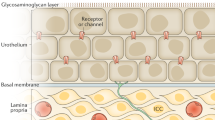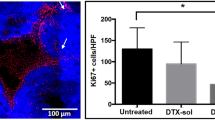Abstract
Our previous studies have suggested that the ineffectiveness of intravesical mitomycin C or doxorubicin therapy against muscle-invading bladder cancer is in part because of the inability of these drugs to penetrate the urothelium (the urothelial drug concentration is <5% of the concentration in urine). The goal of the present study was to identify agents that are efficiently absorbed across the urothelium. To evaluate the potential use of taxol in intravesical therapy for bladder cancer, we examined the bladder tissue and systemic plasma pharmacokinetics of intravesical taxol in dogs. Animals (∼8 kg body weight) were given an instillation of taxol at 500 μg in 20 ml water. At 120 min postinstillation, the bladder was emptied and excised, and about 85% of the dose was recovered in the urine. The taxol concentration in the urothelium was about 50% of the concentration in the urine, the concentrations then declined logarithmically in the underlying capillary-perfused tissues. The average tissue concentration (∼2 μg/g) was two to three times the reported plasma concentration of 0.75 μg/ml in patients following intravenous infusion of the >100-fold higher dose of 250 mg/m2. The steady-state plasma concentration was <0.02% of the average tissue concentration, and was <0.05% of the maximally tolerated plasma concentration in patients. The octanol:water partitioning coefficients of taxol, doxorubicin, and mitomycin were >99, 0.52, and 0.41, which parallels the rank order of the partitioning across urothelium, i.e. taxol (∼50%) >> doxorubicin ≈ mitomycin C (∼3%). In summary, the partitioning of taxol across the urothelium was more favorable than the partitioning of mitomycin C and doxorubicin, and the systemic concentration of taxol resulting from intravesical treatment was insignificant in spite of the extensive absorption into the bladder. We conclude that intravesical delivery of taxol provides a significant bladder tissue targeting advantage, and that taxol represents a viable candidate drug for intravesical bladder cancer therapy.
Similar content being viewed by others
Author information
Authors and Affiliations
Additional information
Received: 20 September 1996 / Accepted: 2 December 1996
Rights and permissions
About this article
Cite this article
Song, D., Wientjes, M. & Au, JS. Bladder tissue pharmacokinetics of intravesical taxol. Cancer Chemother Pharmacol 40, 285–292 (1997). https://doi.org/10.1007/s002800050660
Issue Date:
DOI: https://doi.org/10.1007/s002800050660




